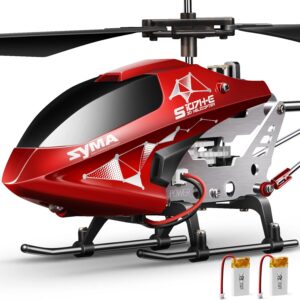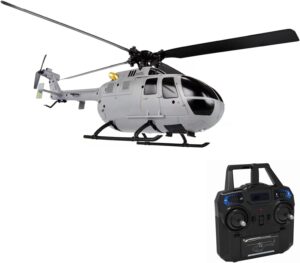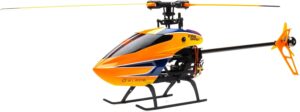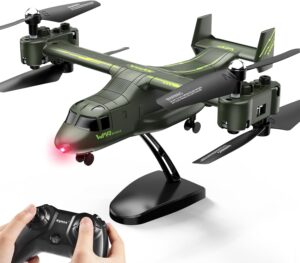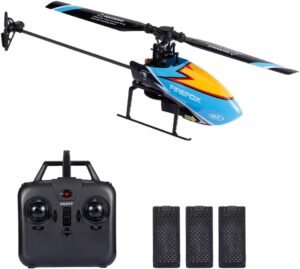Taking to the skies with a remote-controlled helicopter is an exhilarating experience, but for novice pilots, it can also be a daunting task. Navigating the vast array of RC helicopter models available on the market can be overwhelming, especially when you’re just starting out. That’s why we’ve curated a comprehensive guide to the best RC helicopters for beginners. Whether you’re a curious newcomer or a seasoned enthusiast seeking a forgiving and enjoyable introductory model, this guide will equip you with the knowledge and insights to make an informed decision. From stable and easy-to-control designs to feature-rich options that allow for skill progression, we’ll explore a range of helicopters tailored to cater to budding pilots, ensuring a smooth and rewarding journey into the thrilling world of RC helicopter flight.
What Are the Top RC Helicopter Models for Beginners?
1. Syma RC Helicopter with Altitude Hold
Prepare to soar into the skies with the Syma RC Helicopter for Adults and Kids. Boasting a remarkable 16 minutes of flight time, courtesy of two rechargeable batteries, this helicopter offers an unparalleled flying experience. With the option to switch between two speeds, beginners can start at a comfortable pace before progressing to more advanced maneuvers.
The altitude hold mode, powered by a smart chip and air gauge, allows for effortless hovering, making it easier for novices and experts alike to master flying skills. The 2.4GHz frequency ensures a stable and interference-free connection, while the alloy fuselage provides enhanced crash resistance and durability.
With 3.5 channels and one-key take-off and landing functions, controlling this helicopter is a breeze. Its simple operation and kid-friendly design make it suitable for indoor play, opening up a world of adventure and fun for children over 8 years old. Compliant with international safety standards, including ASTM CPSIA CPC, you can fly with confidence, knowing that quality and safety are at the forefront.
2. GoolRC C186 Remote Control Helicopter
With its aileronless design, this helicopter boasts a propeller engineered for superior aerodynamics, delivering strong power and unparalleled stability. The 6-axis gyro stabilization system ensures smooth and controlled flight, making it an ideal choice for those new to the world of RC helicopters.
Equipped with an intelligent modular battery system, the C186 offers easy installation and protection, while the low-voltage alarm feature prevents runaway incidents and allows for seamless transitions between large and small rudder volumes. Constructed with high-quality PA and PC materials, this helicopter is built to withstand the rigors of flight.
Powered by a brushed motor and operating on a 2.4GHz frequency, the C186 ensures a reliable and interference-free connection. With a flight time of up to 15 minutes and a remote control distance of 80-100 meters, you can explore the skies with confidence. Charging the 7.4V 350mAh battery is a breeze, taking only 40 minutes to reach full capacity.
3. Blade RC Helicopter 230 S RTF
Engineered with SAFE Technology, this cutting-edge aircraft offers self-leveling modes and panic recovery features, making it easier than ever for pilots to learn and master the art of collective pitch flying.
Equipped with Smart Technology, the 230 S provides invaluable telemetry feedback to compatible Spektrum transmitters, allowing you to monitor vital flight data in real-time. Its rugged durability is unmatched, boasting a resilient airframe, reinforced rotors, and impact-resistant ABS main blades, ensuring it can withstand the rigors of flight and occasional mishaps.
Powered by a Spektrum DXS transmitter with DSMX 2.4GHz technology, you’ll experience complete range control, flight pack voltage monitoring, and ergonomic design for fatigue-free flying. The metal gear cyclic servos deliver high-speed responsiveness, while the direct drive tail motor ensures impressive heading hold with its simplistic design.
With vivid canopy and bright main blades and tail, maintaining orientation is a breeze, even in challenging conditions. Fully assembled and ready to fly, the Blade 230 S RTF Basic is a true collective pitch confidence builder, designed to help pilots of all skill levels achieve mastery in the skies.
4. SYMA X550 Military RC Helicopters
Experience the thrill of military-grade aviation with our RC Helicopter for Adults and Kids. Derived from the proportional downsizing of a real military helicopter, this meticulously crafted aircraft offers an immersive and unparalleled piloting adventure. Whether you aspire to command a real aircraft or indulge in flight simulations, our helicopter is tailored to exceed your expectations.
Unleash your piloting prowess and execute a variety of aerial acrobatics, including spin-ups, circular flights, and thrilling leaps. Captivate onlookers with your skilled flying abilities and leave a lasting impression. With a 2-speed switch mode, you have the flexibility to adjust between high and low speeds, catering to both beginners and experienced pilots alike.
Enhance your flying experience with the integrated LED light effects, ensuring you can track the helicopter in dark conditions and alerting you when the battery power is running low. This dual functionality allows you to enjoy your flights with confidence and peace of mind.
Equipped with a one-key start and altitude hover function, our remote control helicopter ensures a smoother and more enjoyable flying experience for both kids and adults. Whether you’re a beginner or an experienced pilot, this aircraft is designed to meet your specific needs and provide endless hours of aerial excitement.
5. GoolRC C129 RC Helicopter
This 4-channel, 2.4GHz remote control helicopter boasts a 6-axis gyro, ensuring remarkable stability and control during flight. With its aileronless design, this helicopter offers unparalleled flexibility and power, making it perfect for pilots of all skill levels.
Compact and portable, the C129 is an ideal travel companion, allowing you to enjoy flying adventures wherever you go. Its aileronless design not only reduces weight and drag but also minimizes the need for excessive manual corrections, providing a more stable and forgiving flight experience.
Equipped with a 6-axis gyroscope, this helicopter achieves exceptional flight stability, making it an ideal choice for beginners looking to hone their skills. The 2.4G remote control boasts a range of up to 100 meters, and its anti-interference frequency allows multiple aircraft to fly simultaneously in the same space.
Moreover, the intelligent air pressure altitude hold function accurately locks the flight altitude, enabling stable hovering and easier control, further enhancing the overall flying experience.
What Makes a Good RC Helicopter for Beginners?
When starting out with RC helicopters, it’s essential to choose a model that is specifically designed for beginners. These helicopters are built with stability and ease of control in mind, making them more forgiving and less prone to crashes compared to advanced models.
One of the key features that makes a good beginner RC helicopter is a stable flight design. This typically involves a coaxial rotor system, which means two rotor blades spinning in opposite directions on the same axis. This configuration provides inherent stability and resistance to the torque that can cause traditional single-rotor helicopters to spin uncontrollably.
Another important factor is the presence of advanced stabilization systems, such as gyroscopes or barometric pressure sensors. These systems help keep the helicopter level and steady, compensating for wind gusts or pilot input errors that could otherwise cause it to lose control or crash.
Ease of control is also crucial for beginners. Many entry-level RC helicopters come with simple, intuitive transmitters that have fewer channels and controls than advanced models. This reduces the learning curve and allows new pilots to focus on mastering the basics of flight before attempting more complex maneuvers.
Durability is another key consideration, as crashes are inevitable when first learning to fly an RC helicopter. Beginner models are typically made with lightweight yet sturdy materials like plastic or foam, which can withstand minor impacts without sustaining significant damage.
Finally, a good beginner RC helicopter should have features like dual rates or beginner modes that limit the helicopter’s sensitivity and responsiveness. This allows new pilots to practice in a more controlled environment before gradually increasing the helicopter’s agility as their skills improve.
By prioritizing stability, ease of control, durability, and beginner-friendly features, aspiring RC helicopter enthusiasts can enjoy a smoother and more rewarding learning experience, ultimately building the foundation for more advanced flight in the future.
What Are the Different Types of RC Helicopters?
RC helicopters can be broadly categorized into two main types: fixed-pitch and collective pitch. Each type has its own unique characteristics and caters to different skill levels and flying preferences.
Fixed-pitch RC helicopters, also known as coaxial helicopters, are often considered the best choice for beginners. These models feature two main rotor blades that spin in opposite directions on the same shaft, providing inherent stability and resistance to torque. The pitch of the blades is fixed, meaning the angle of the blades cannot be adjusted during flight. This simplifies the controls and makes fixed-pitch helicopters easier to maneuver, especially for those new to the hobby.
On the other hand, collective pitch RC helicopters are more advanced and offer greater control and maneuverability. In these models, the pitch of the main rotor blades can be adjusted collectively during flight, allowing for more precise control over altitude, speed, and maneuvers. Collective pitch helicopters typically have a more complex control system, with separate channels for controlling the collective pitch, cyclic pitch (for directional control), and tail rotor pitch.
Within the collective pitch category, there are further distinctions based on the number of main rotor blades. Single-rotor helicopters, with either three or four blades, are the most common and generally offer better performance and agility compared to their coaxial counterparts. However, they are also more challenging to control, especially for beginners, due to the torque effect caused by the spinning main rotor.
Another type of collective pitch RC helicopter is the tandem rotor design, which features two main rotor systems side by side, spinning in opposite directions. This configuration provides excellent stability and control, but these models are typically more expensive and better suited for experienced pilots.
In addition to the main types, RC helicopters can also be classified based on their size, with options ranging from tiny indoor models to large-scale outdoor helicopters. The size and weight of the helicopter can significantly impact its performance, stability, and the level of skill required to fly it effectively.
Understanding the different types of RC helicopters is crucial for beginners, as it helps them choose a model that aligns with their skill level and desired flying experience, ensuring a more enjoyable and rewarding introduction to this exciting hobby.
What Should I Look for in a Beginner-Friendly RC Helicopter?
When starting out with RC helicopters, choosing a model specifically designed for beginners is crucial. These helicopters are engineered with features that make them easier to control, more stable, and less prone to crashes, ensuring a smoother learning experience.
One of the most important aspects to consider is the rotor configuration. Coaxial helicopters, which have two main rotor blades spinning in opposite directions on the same shaft, are an excellent choice for beginners. This design provides inherent stability and resistance to torque, making them much more forgiving than traditional single-rotor helicopters, which can be challenging for novice pilots to control.
Advanced stabilization systems are another key feature to look for in a beginner-friendly RC helicopter. Many entry-level models incorporate gyroscopes, barometric pressure sensors, or other technologies that help keep the helicopter level and steady, compensating for wind gusts or pilot input errors that could otherwise cause it to lose control or crash.
Ease of control is also essential for beginners. Look for RC helicopters with simple, intuitive transmitters that have fewer channels and controls than advanced models. This reduces the learning curve and allows new pilots to focus on mastering the basics of flight before attempting more complex maneuvers. Some models even offer dual rates or beginner modes that limit the helicopter’s sensitivity and responsiveness, providing a more controlled environment for practice.
Durability is another vital consideration, as crashes are inevitable when first learning to fly an RC helicopter. Models made with lightweight yet sturdy materials like plastic or foam can withstand minor impacts without sustaining significant damage, reducing the cost and frustration of frequent repairs or replacements.
Additionally, look for RC helicopters that come with training gear or accessories, such as landing skids, blade guards, or even simulators, which can help beginners practice and gain confidence before attempting real-world flights.
Finally, consider the overall size and weight of the helicopter. Smaller, lighter models are generally easier to control and less susceptible to wind gusts, making them a better starting point for beginners before progressing to larger, more powerful helicopters.
By prioritizing features like a coaxial rotor design, advanced stabilization systems, intuitive controls, durability, training accessories, and a manageable size, beginners can enjoy a more rewarding and less frustrating introduction to the exciting world of RC helicopter flying.
How to Choose the Best RC Helicopter for Beginners?
Are you captivated by the idea of piloting your own remote-controlled helicopter, but unsure where to start? Fret not, dear reader, for this comprehensive guide will equip you with the knowledge to choose the perfect RC helicopter to kickstart your aerial adventures. With a wealth of options available, selecting the right one can be a daunting task, but fear not – we’ve got you covered. Buckle up and prepare for an exhilarating journey into the realm of RC helicopters!
Understanding Your Needs: The Key to Unlocking Success
Before delving into the specifics of RC helicopters, it’s crucial to assess your goals and expectations. Are you seeking a leisurely hobby to unwind after a long day, or do you envision yourself mastering advanced maneuvers and tricks? Identifying your aspirations will help narrow down the choices and ensure a gratifying experience from the get-go.
Beginner-Friendly Features to Look For
When embarking on your RC helicopter journey, certain features can make your life significantly easier. Firstly, consider opting for a coaxial design, which utilizes two rotors stacked one above the other. This configuration offers enhanced stability and control, making it an ideal choice for novice pilots. Additionally, seek out helicopters with built-in stabilization systems, as they help counteract external factors like wind gusts, allowing you to focus on honing your piloting skills.
Size Matters: Choosing the Right Dimensions
The size of your RC helicopter plays a pivotal role in determining its maneuverability and flight characteristics. For beginners, it’s generally recommended to start with a smaller model, typically ranging from 6 to 10 inches in length. These compact helicopters are easier to control and less prone to damage from inevitable crashes during the learning curve. As your skills progress, you can gradually transition to larger and more advanced models.
Power and Performance: Striking the Perfect Balance
At the heart of every RC helicopter lies its power source – the battery. When selecting a model, pay close attention to battery life and charge time. Longer flight times will allow you to maximize your practice sessions, while shorter charge times will minimize downtime between flights. Additionally, consider the motor’s power output, as it directly impacts the helicopter’s speed and agility.
Durability: Preparing for the Inevitable
Let’s face it, crashes are an inevitable part of the learning process when it comes to RC helicopters. That’s why it’s crucial to prioritize durability when making your selection. Look for models constructed with high-quality materials, such as durable plastic or carbon fiber, which can withstand the occasional impact. Additionally, consider helicopters with replaceable parts, making repairs and maintenance more cost-effective in the long run.
Ready for Takeoff: Explore Your Options
Now that you’re armed with the essential knowledge, it’s time to explore the plethora of options available on the market. Some renowned beginner-friendly RC helicopter models include the Blade Nano QX, the Syma S107G, and the Hubsan X4 H107C. Each of these models offers a unique blend of features, performance, and affordability, catering to various preferences and budgets.
Frequently Asked Questions when Picking the Best RC Helicopter for Beginners
Q1: What is the best RC helicopter for an absolute beginner?
A1: For complete beginners, the Blade Nano QX is often considered one of the best options. This ultra-micro helicopter is incredibly stable and durable, making it an ideal choice for those just starting their RC journey. Its coaxial design and built-in stabilization system allow for smooth and controlled flights, minimizing the risk of crashes while you hone your skills.
Q2: What size RC helicopter should a beginner start with?
A2: When starting out, it is generally recommended to begin with a smaller RC helicopter, typically ranging from 6 to 10 inches in length. Smaller models are easier to control and less prone to damage from inevitable crashes during the learning curve. As your skills progress, you can gradually transition to larger and more advanced models.
Q3: What features should a beginner look for in an RC helicopter?
A3: Beginner-friendly features to prioritize include a coaxial design (two rotors stacked one above the other for enhanced stability), built-in stabilization systems, durable construction materials (e.g., high-quality plastic or carbon fiber), and replaceable parts for easier maintenance and repairs.
Q4: How important is battery life for a beginner RC helicopter?
A4: Battery life is a crucial consideration for beginners. Longer flight times allow you to maximize your practice sessions and hone your skills without frequent interruptions. Look for models with battery capacities that offer at least 5-8 minutes of flight time, and consider investing in additional batteries to extend your flying sessions.
Q5: What is the best way to practice with a beginner RC helicopter?
A5: When starting out, it is recommended to practice indoors or in a controlled outdoor environment with minimal wind. Begin by mastering basic maneuvers, such as hovering, gentle turns, and smooth landings. As your confidence grows, gradually introduce more advanced techniques like flips and rolls. Additionally, consider investing in a flight simulator or training gear to further enhance your skills before taking to the skies.
Q6: How durable do beginner RC helicopters need to be?
A6: Durability is crucial for beginner RC helicopters, as crashes are inevitable during the learning process. Look for models constructed with high-quality materials, such as durable plastic or carbon fiber, which can withstand occasional impacts. Additionally, consider helicopters with replaceable parts, making repairs and maintenance more cost-effective in the long run.
Q7: Can a beginner fly an RC helicopter outdoors?
A7: While it is generally recommended to practice indoors initially, outdoor flying is certainly possible for beginners with the right preparation and precautions. Start in calm weather conditions and choose an open area with minimal obstacles. As your skills improve, you can gradually transition to more challenging outdoor environments, but always prioritize safety and follow local regulations.
Q8: How much should a beginner expect to spend on their first RC helicopter?
A8: The cost of a beginner-friendly RC helicopter can vary, but a good range to consider is between $50 to $150. Entry-level models like the Syma S107G or Hubsan X4 H107C offer excellent value for money and a suitable starting point. As you gain experience, you can invest in more advanced and feature-rich models, which may cost more but offer enhanced performance and capabilities.
Q9: Are RC helicopter simulators useful for beginners?
A9: Absolutely! RC helicopter simulators can be incredibly helpful for beginners, allowing you to practice and refine your skills in a virtual environment before taking to the skies with a physical model. These simulators provide a risk-free environment to learn basic maneuvers, experiment with different techniques, and gain confidence without the fear of damaging your helicopter.
Q10: What is the best way to maintain and care for a beginner RC helicopter?
A10: Proper maintenance is essential to ensure the longevity and performance of your RC helicopter. Follow the manufacturer’s guidelines for battery care, regularly inspect and replace worn parts, and keep your helicopter clean and free from debris. Additionally, invest in a quality toolset specifically designed for RC helicopter maintenance, and consider joining online communities or local clubs to seek advice and support from experienced enthusiasts.
Final Thoughts
Embarking on the thrilling journey of RC helicopter piloting is an experience like no other. With the knowledge and insights gained from this comprehensive guide, you are now well-equipped to make an informed decision and select the perfect RC helicopter to kickstart your aerial adventures.
Remember, the key to success lies in understanding your needs, prioritizing beginner-friendly features, and striking the right balance between size, power, and durability. Whether you’re seeking a leisurely hobby or aspiring to master advanced maneuvers, the right RC helicopter will serve as your trusty companion, providing countless hours of exhilaration and accomplishment.
Enjoyed this guide of best RC helicopter for beginners? Then be sure to check out our other RC Rating guides.
